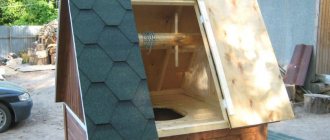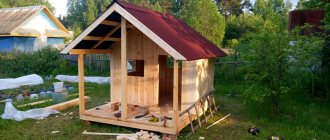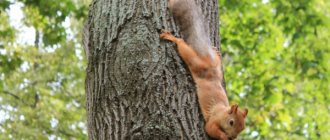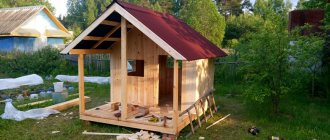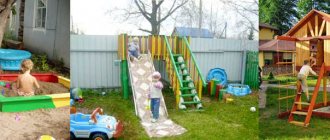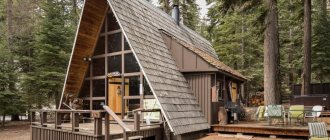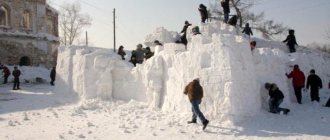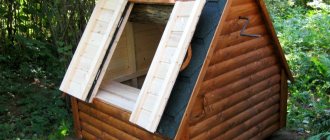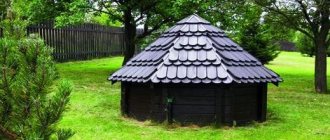It’s easy for adults to find something to do, but children at the dacha or in a country cottage often get bored. The problem is acute if there is no Internet or game consoles. But what will save you in this case are the children’s cottages made of wood that you can build for them! And how to do this, read this article.
- Gender designation
How relevant is the playhouse?
A children's house made of wood, built specifically for a child, is guaranteed to become the most popular summer cottage object, since it can be presented not just as an ordinary box with holes and windows, but as a full-fledged and even completely residential object. It’s easy to turn it into an original gaming center.
A children's wooden tree house will look most interesting in this regard. It’s easy to imagine the building as multifunctional, and then the kids will never get bored in it. Make your children's treehouse colorful and visually appealing. Equip it with spiral slides, a rope, a suspended staircase and other interesting attractions. Believe me, all this will be received with a bang!
Any child will love the tree house
The approach to the issue of arranging such a zone can be varied. The easiest way, of course, is to buy a ready-made structure, but if you want to give your children a truly fascinating world, build a children’s wooden house with your own hands. The remarkable thing is that you will not need the help of an architect. Your child will tell you which design he would like to have at his disposal.
You can make a tree house with your own hands
While working on a project, sit your child next to him and ask how he sees a children’s house in the country: color, size, location. Does he want to have additional entertainment in this corner, such as ladders, tables, swings, or will he be completely satisfied with the interesting interior arrangement of a children’s house in a tree or in the garden? You can show him several options for architectural solutions from the Internet, maybe something will attract him. By the way, you yourself will find there many tempting ideas for creating a children's corner.
Offer your child several sketches of the future house
We equip the stairs
How to build a house with a safe entrance? After all, you will have to rise several meters above the ground. Pay enough attention to the construction of a high-quality staircase. It must have railings. But a house built for children can be equipped with a rope ladder. And the children are interested, and you have less work. If you want to make an ordinary staircase, then the easiest way would be to take a large and high-quality extension ladder, secure it well and make the steps wider. Do not forget about the railings that a person will hold on to when ascending and descending.
Types of children's houses in the country
Of course, the children's playhouse will be built in accordance with the fantasies of the future owner, but still it will most likely belong to one of the popular varieties.
Hut house
This is a simple children's wooden house, with only a window and a couple of benches inside. The design is attractive due to its ease of installation and unpretentious dimensions. The hut house is most often found on small dacha plots.
Simple treehouse
Green house
The object will delight lovers of organic architecture. It is built, unlike a tree house for children, without special expenses: just install a mesh frame and select the right assortment of greenery that will entwine it, becoming a living roof and walls. A green house will be a source of your pride and the envy of your neighbors.
Original house made of branches
Hut house
A model of a real village hut in miniature. Such a children's house is built from wood, sometimes even, for greater similarity with the original, from a log house. The option is not too fancy, but it is very interesting for school-age children, as it gives a feeling of adulthood and complete independence.
Tree house for children
Duplex house
This is not just a claim to a gaming area, but a claim to your own little world. The lower tier of a children's wooden house built with their own hands is reserved for the kitchen or for studying, and the upper tier is equipped for games. A wonderful move would be to combine the building with a sports corner. For example, let your child choose how he wants to get to the top of the house:
1. Traditionally, climbing the stairs.
2. Climbing a rope.
3. Climbing along inclined cellular flooring, etc.
Near the children's wooden house itself, you can dig an additional beam with a support and hang a swing on it.
Children's play center on a tree
Fairytale house
This category of children's houses in dachas includes all designs of non-standard shapes: ships, rockets, castles, interpretations of the homes of Hobbits, Baba Yaga, gnomes, etc.
Fairytale hobbit tree house
Shelter
This is an easy building in terms of complexity. It will not save you from frost and wind, since the second half of the shelter is open. A temporary shelter provides protection from sun and rain. Used in summer or late spring, when the air temperature allows you to comfortably spend the night outside.
Step-by-step installation:
- Choose a clearing with two trees or install 2 supports in the ground. Fallen trees will serve as such pillars. To sleep lying down, provide a width of at least 200 cm.
- You will need several poles with a cross-section of at least 5 cm. This thickness will support a layer of spruce branches or branches from bushes and moss. The poles are placed on the crossbar and pressed into the ground. The distance between the elements is no more than 10 cm. The branches are installed so that they extend beyond the crossbar, forming a canopy.
- Spruce branches, dry leaves, ferns, and straw are laid on the roof. Form a thickness of 20 cm.
A thick flooring of branches is installed inside the overnight shelter. Spruce branches, moss, leaves or straw are placed on top. A fire pit is made near the open part of the building.
Children's tree house
It may not be so easy to build a treehouse with your own hands, but this solution usually causes the greatest delight among children. This is where there is freedom for imagination! This is where the most gambling is organized. Having decided to do something like this, it is better to involve a professional in order to think through everything in detail and securely secure it. A tree house for children is an object of increased danger, so during its construction you will have to provide for many nuances, among which there will be no trifles.
Children's house made of wood or...?
What to build a playhouse from is a question no less relevant than in what form. Anything can become a building material:
- modern plastic;
- branches;
- beam;
- board;
- plywood;
- stone;
- improvised material.
Plastic
“You shouldn’t attach a plastic house for children on a tree, even at their very strong request.”
Such a children's house can only be assembled with one's own hands. Ready-made disassembled structures are purchased in stores and simply installed at the dacha. Plastic houses are attractive due to their safety, hygiene, colorful solutions, and light weight. Often these are mobile buildings that are rented for the winter. They are interesting to kids. They can be placed in the garden, but a plastic house for children on a tree should not be attached, even at their very strong request. The option is quite fragile and difficult to modify, so it’s better not to overthink it.
A plastic house is installed at a low height
Plywood
Even non-professionals can work with this lightweight, cheap material, which is why it is most often chosen for DIY work on a children’s wooden house. True, complex projects cannot be realized from plywood, but a decent play area for preschoolers is quite possible.
Building a house from plywood is not difficult
Tree
In this category, buildings are made of wood of any quality of processing or without it. The latter is acceptable for organizing a play area for children of conscious age. The branches are used to build something like huts and huts. Planed timber will allow you to build a more solid children's house in the country, resembling real housing as closely as possible, with an internal layout, possibly even insulation and heating.
A children's house made of wood is environmentally friendly and highly durable. You don't have to worry that it will be destroyed by playing children. Moreover, staying in a house made from pine boards will have a beneficial effect on children's health.
Children's house made of wood is highly durable
A complete house with thoughtful finishing and design will become a place for educational games and will help the child feel independent. Another advantage of permanently built wooden houses is that you can play in them in any weather.
Can a children's wooden house be located on a tree? Undoubtedly! This is another compelling argument to take a closer look at the material.
Well, in conclusion, it is worth noting that as the children grow, the need for a house as a playground will disappear over time, and the building can be re-qualified as a farm building.
The same can be said about a stone children's house in the country, but they will have to be built in tandem with a mason, and you cannot place a stone children's house on a tree.
Advantages and disadvantages
Before you decide whether to start building a wooden house yourself or hire professionals, you need to weigh all the advantages and disadvantages.
The advantages of self-building are
- the opportunity to build a house according to your own design;
- personal participation at all stages of construction;
- gaining experience in construction work;
- budget savings (no need to pay a team of workers);
- the ability to build a house in stages;
- confidence in the quality of construction.
There are also disadvantages to such construction:
- waste of time and effort;
- you need to find an assistant, since it is impossible to build a house without outside help;
- the need to independently select and order material;
- low construction speed. The process may take years;
- Lack of experience can lead to mistakes in construction, which will lead to problems in the future.
DIY children's wooden house
Like any work on a construction project, the construction of a playhouse begins with the development of a project. What should you think about?
1. Above the installation method. Stationarity or mobility – that is the question. The choice will affect the size of the building and the actual technology of its construction.
2. About the number of windows. There must be at least two of them. First of all, this will allow for good illumination of a wooden children's house, and secondly, it will make it possible to control what is happening inside.
Several windows will allow you to control what is happening inside the house
3. About the height of openings. The windows are raised above the floor by at least half a meter. In the finished elements of the door frame, the height is added slightly, 20 - 30 centimeters more than the height of the child, but when you build a children's wooden house with your own hands, you can adapt it to your height, because you will probably be invited to visit more than once, and the interior decoration will be like - will need to be produced.
4. Above the roof shape. This part should not be made flat so as not to provoke children to climb on it.
What are we building from?
To build a simple children's wooden house you will need to purchase:
1. Sheets of plywood in the amount of 4 pieces with dimensions of 1.7 x 2 m.
2. Bars two and a half meters long and with a cross section of 250 x 250 mm. Of the 13 pieces, 8 will need to have one end sharpened with a stake.
3. Bars of a similar section, but with a length of 35 cm. 8 of them are needed. They will become the support of the floor.
4. 17 two-meter boards with a section of 5 x 15 cm. These are elements of a horizontal clip and flooring.
5. Roofing material for covering the roof. You can choose whatever you like from eco-products.
6. Metal corners.
7. Paint and varnish.
8. Self-tapping screws.
9. Brushes.
Tools for making a children's house
Marking a site for a wooden children's house
A playhouse is a child’s personal space, but this does not mean that you can leave it there unattended, so when looking for a place to build it, choose places that are easily visible.
Having selected the area, start marking it. You can skip this moment only when building a tree house for children. Take pegs and rope in your hands and fence off the area of the required size and given shape. Now start leveling and compacting it.
Digging in the supports of the future house
In the corners or diameter of the resulting base, holes are dug at intervals of 20 cm. Short beams are lowered into them and dug in. The height of the above-ground part of the block should be 20 cm. Work is carried out using a level so that the future children's wooden house does not turn out skewed.
The next step will be to attach 4 boards to the supports, on which the floors will later be laid.
Attaching boards to supports
Making walls
Work on them begins with the assembly of blanks. The height of the chipboard sheets is attached to a pointed beam, and this is done so that the upper smooth edge is flush with the plywood edge, and the sharp lower edge protrudes beyond its boundaries. One plywood sheet supplemented with beams = one wall.
Assembling the walls of a children's house
In each element, according to the plan, we make an opening for a window or door. The “finished” walls are driven in with a sledgehammer close to the finished flooring. When building a children's wooden house with your own hands, you need to do it so that the wall “sits” tightly on the floor.
Don't forget to leave openings for windows
The panels are fixed together with corners and screws, making sure that no cracks or gaps appear.
Putting on the roof
Let's start with the form. The slopes can be made steep and flat. For a high roof, you will have to assemble a frame from the same long beams, cut in half and connected at right angles, and attach the sheathing to the improvised rafters. In a children's treehouse, it may be difficult to implement such an idea, so flat roofs are often installed there.
Making a flat roof
The corners of the connection are taken from both sides on a metal corner. This is necessary to impart good rigidity and increase the strength of the supporting frame. As a covering, you can use plywood, laminate, slate, lath, even pieces of linoleum. Empty corners under the roof, the front and rear of the house are covered with plywood. It can be decorated with carvings, burning, or an original dormer window.
The roof must be securely screwed to the house
Decor of a children's house in the country
“Children should not be allowed to decorate a treehouse with their own hands.”
In this part, it is worth actively involving the child in the work. Feel free to give him paints and brushes. Let him work on decorating the walls and doors himself.
What are the options? Yes, anything: from colorful drawings to outright blots. You can suggest an idea for wall decor with handprints. Children usually take on this work with pleasure. Girls can try to paint surfaces with flowers, rainbows, and bows. Children should not be allowed to decorate a treehouse with their own hands. It may be dangerous.
Final work on decorating the house
Main stages of construction
The simple design of A-shaped houses allows you to build them at your dacha with your own hands; detailed drawings are presented below. The main thing is to develop the layout correctly.
Construction planning, as with the classic version, must begin with the selection of materials. The frame is usually made of wood. But the roofing can be made from absolutely any suitable material: from corrugated sheets, tiles (it’s better not to take metal tiles, because they have zero sound insulation, and every blow to the roof will be reflected indoors), slate, bitumen or the same wood. By the way, from a design point of view, it is better to choose a contrasting roof - this will make the house even more interesting. Work must begin step by step, with the preparation of the foundation. You need to select a suitable piece of land, clear it and mark the intended area. It is customary to install a columnar or pile foundation. The frame consists of ordinary wooden beams of the required size, folded in the shape of the letter A and connected at a certain angle. This is all collected separately on the ground. The necessary, pre-calculated number of such corners is made. Internal partitions are assembled and installed in a similar way. Then, according to the following scheme, the assembled beams are installed on the foundation at strictly equal intervals: first the extreme corners, after them the middle ones. If necessary, a load-bearing floor is installed to separate the floors. The next step is the construction of the roof. The frame is sheathed on top either with wood or with panels of the selected material. It would be optimal to use corrugated sheeting from the point of view of wear resistance and durability, but it gets very hot in the sun and is susceptible to rust, since it is a typical metal. After installing the external facade, you can begin to work on the internal landscaping and interior design. It is also advisable to sheathe the inside of the house with wood. This is both a beautiful and heat-resistant material. Before this, you can use any heat and sound insulating panels. Installed boards are primed and varnished
If the house is two-story, it is important to position the staircase correctly - it should delimit the space into different zones, for example, the kitchen and living room. Or be moved to the far end and simply rest against the wall that isolates the bathroom. After the walls, it’s natural to start installing window frames
The larger they are, the better. This will visually expand the space. It is also important to make panoramic windows on the entire wall facing south. Then it’s time to finish the floor. Moreover, it should be remembered that under the floor covering there must be a layer of waterproofing and insulation. The interior can be made in any style, but when arranging details, do not use things that “conceal” the space. The color scheme can be either muted (if you chose the option with panoramic windows) or light (an alternative if natural light was not enough). Zoning plays a key role in such a house - it is thanks to it that it will be possible to distribute the compact space wisely and comfortably.
Simple wooden house
Often, children are lucky enough to receive for personal use not a landscaped area, but a wild wigwam or hut. Do not deprive them of such pleasure, especially if there is enough building material at the dacha. A lightweight children's house made of wood, or rather, from its branches, can be assembled in a couple of hours. Before construction, be sure to organize a fire pit. It can be improvisation or a completely active element. Lay a homespun rug inside the wigwam, and dig a moat around it so that rainwater does not flood the architectural improvisation.
An example of a simple children's hut house
Cone option
A structure similar to a tent or wigwam provides good protection from adverse weather, especially rain and snow. The advantage of the structure is the use of a fire indoors. However, you will have to think about the chimney.
Step by step assembly:
- If a fire is not used inside the hut, then a thick support is installed in the middle of the future tent, dug deep into the ground.
- From the post at a distance of 100 cm around the circumference, poles are driven in and placed on the top of the post.
- The upper part of the structure is tied with a rope and pulled together. Excess protruding branches are cut off.
- The poles are covered with a thick layer of moss or spruce branches.
To use a fire indoors, you will have to make the hut in the forest a little different. At the beginning of construction, a pole is placed, strong sticks are dug in around the perimeter and placed on the central support. The branches are fixed horizontally at 4 levels. Thin branches or moss are placed on the crossbars.
All connections are connected, except for the middle post, it is removed so that free space for the fire is created inside the room, and a hole remains in the roof for smoke to escape.
Tree house for children
Modern life is so practical that there is absolutely no place for a fairy tale in it. But she should be in the childhood phase. If you are unable to allocate space for a children’s playground due to time pressure with a summer cottage area, arrange a children’s tree house for your children. This idea will be easiest to implement for those who have a multi-stemmed tree in their garden. Among them, the structure will stand firmly and look relevant. Whether to assemble a children's tree house with your own hands or entrust it to a specialist - decide for yourself. The result is important here, and not the satisfaction of one’s ambitions, because the playing area must, first of all, be reliable, and also, preferably, adapted to life. The child should be able to fully rest in it, perhaps even take a nap.
A tree house for children can become a chic landscape element. Just imagine a dacha, in the depths of the garden of which you can see an exact copy of the main house. It will be at least interesting.
A tree house will decorate your site
When planning to build a children's house on a tree with your own hands, do not forget that it needs to be done from lightweight materials. A brick building will simply collapse under its own weight.
When deciding what the house will be like, rely on the role assigned to it. If this is exclusively a place for children’s games, then you can interpret it in any form. If you want to make a universal treehouse for both children and evening gatherings for adults, take care of the specifics of the interior decoration.
How to decorate a tree house
Yes, in any interpretation, actually. It can be imagined as a modest building with an attached wooden staircase for climbing up or its rope equivalent, or it can be turned into a whole entertainment town. A house in the shape of a ship's deck, a castle, or a grotto will be attractive for a child.
House - a pirate ship on a tree
The construction site for a children's house in the country can be a spreading tree or a slender pine tree. It can be hidden in the branches or built around the trunk. To create a large-scale project, you can use nearby trees, connecting them to the house and each other with cable cars, providing horizontal bars, swings, ropes and slides.
What is inside?
In a permanent children's tree house, as well as in one standing on the ground, it is very important to carry out zoning. If there is sufficient space, they should provide a place for working, sleeping and eating. You may even be able to highlight the living room, which will certainly delight the little owner. After all, now he will be able to comfortably receive friends and practice the role of a hospitable host.
Treehouse interior
When constructing a children's tree house with your own hands, try to make it a veranda or balcony. You can hang a hammock on the veranda, and furnish the balcony as a place for creative activities.
Treehouse with a cozy balcony
It’s good to put a mini-sofa, wicker chairs and a table in the children’s house. If possible, be sure to install a fireplace and provide electricity. If there are no such conditions or the object is mobile, place flashlights in it. It will also turn out interesting and mysterious.
If possible, bring light into the house
A reading area may appear in a children's house in the country. It is furnished with a bookcase and a comfortable chair. You can hang transparent curtains on the windows. In general, if desired, the interior decoration of the building can be done in any style, the main thing is that it suits the child’s vision.
Organization of space inside the treehouse
Consumables
To build a children's house with your own hands, you will need the following materials: wooden blocks for piles, chipboard, screws, nails, a metal slide, a ladder (can be made as a team).
It is very simple to explain why particle board is used - firstly, it saves an impressive amount of money, and secondly, there is absolutely no need to use more expensive materials. If you are worried that the house will be unreliable, then you can reassure yourself that it can be repaired if necessary.
Wooden structures are connected using the tongue-and-groove method, this allows you to easily and quickly disassemble the house in the winter, if necessary.
Assembling the window frame:
Blank for the future manhole cover:
You must remember that you will definitely need cement, sand for the foundation and paint to give the structure a favorable appearance.
General recommendations for arranging children's houses with your own hands
Make the space of the house enclosed, so it will be more comfortable. The floors can be covered with something soft, such as an old blanket or mats.
There should always be light inside the orphanage, preferably dim. This will create the most comfortable atmosphere. In the evening, a flashlight is required.
Cozy treehouse interior
Ceilings should not go sky-high. Their optimal height is no more than half a meter from the child’s height. This will be the best confirmation that you really built a children’s wooden house with your own hands and will not enter it without an invitation.
Fill the environment with all sorts of surrounding things that are familiar to the child in real life. If this is a pirate lair, there should be a bottle for sealing messages, a chest for storing treasures and, of course, a corresponding flag. In the princess's boudoir you will need a mirror, an old telephone, and various glamorous things. You can't do without a radio on a ship. In general, give your children everything that might be interesting, and they will figure out what to do with it themselves.
Decorating a tree house
The process of glazing hut houses
Previously, in such houses there were problems with lighting through daylight, because windows could only be installed on the surfaces of the gables. Over the past ten years, this problem has lost its former relevance, as a huge variety of attic windows have appeared, mounted directly on the roofing surface of an A-shaped country house.
If summer residents have the means and aesthetic appearance is more important to them than savings, you can install panoramic windows that will replace a section of roofing or pediment.
This glazing gives the “hut” airiness, lightness, and transparency, filling the entire space with light.
Safety comes first
“When working on a children’s wooden house with your own hands, screw in the screws correctly: their caps and sharp ends should not protrude above the surfaces.”
A wooden children's house must be safe. This can be ensured by the right approach to the selection of materials and the construction process.
A children's house in the country should not be in the sun or in dense shade. In the first case, it will be hot in it, and the child may get sunstroke; in the second, it will be damp, and the place of play will smell of mold.
Place the play area on a flat area or mount the children's house on a tree with strong branches. The design must be reliable. Not wobbly or rolly. The child will run and jump inside and this should not affect the condition of the house in any way.
Make sure the structure of the house is reliable
Check the quality of the building materials. The boards and bars must be well-planed so that the baby does not develop splinters.
When working on a children's wooden house with your own hands, screw in the screws correctly: their caps and sharp ends should not protrude above the surfaces.
When decorating the roof, especially in houses for the little ones, use elastic and flexible materials such as polycarbonate. Ordinary slate or metal have quite sharp edges and can injure children playing.
Selecting Support Trees
Before starting to build a planned house, it is very important to take a responsible approach to the choice of support trees.
The quality and level of safety of future construction will depend on their condition. A home craftsman who decides to build such an interesting structure on the site with his own hands must know which trees are suitable for this.
- You can only use trees that have a perfectly healthy trunk. The latter should not even have a hint of rot. Also, the trunk should not be affected by insects, any diseases, or empty cavities. Such defects will certainly affect the durability of the base for the house.
- It is necessary to select durable trees that will last for many years and will not suffer from temperature changes.
- The most reliable support will be an adult tree that has already fully formed. It is desirable that it have wide and branched branches, a deep root system, and a thick trunk. Such a foundation will be quite strong and stable.
The following types of wood can be used as a kind of “foundation” for a children’s house:
- oak is the strongest species, characterized by the presence of spreading branches;
- beech is also very strong and reliable;
- walnut is one of the most durable types of wood;
- spruce;
- Apple tree;
- poplar;
- maple;
- Linden.
It is too flexible and therefore not suitable for such construction operations. Selecting the right type of wood is not everything
It is equally important to pay attention to the diameter of the barrel, which will serve as the basis for the future design. So, for a house whose area will be only 9 square meters. m, you will need a tree with a diameter of at least 30 cm
If the main branches of the tree are located in the shape of the letter V, it is best to place the floor slightly above the junction of the main branches of the crown
m, you will need a tree with a diameter of at least 30 cm. If the main branches of the tree are located in the shape of the letter V, it is best to place the floor slightly above the junction of the main branches of the crown.
It often happens that there is no suitable tree on the site, and children ask to build them a house. The way out of this situation would be to erect a building on a stump or log. Of course, the structure must have a suitable shape and load capacity. Outwardly, such buildings resemble Baba Yaga’s hut somewhere in a dense forest and kids like them no less than houses built on an oak or spruce tree.
Photo gallery – children's treehouse
Deciduous trees
Let's get acquainted with the main types of deciduous trees that are found in cities, forests and parks of our country.
Birch
The most beloved tree in Russia is often called the “tree of life”, “Russian beauty”, “bride”. Birch is easily recognized by its trunk, covered with almost white bark - birch bark. The leaves of the birch are not large, the crown is not too thick, it allows light to pass through, so it is rarely dark in the birch forest.
This tree grows throughout Russia - and not only. Due to its unpretentiousness, birch is found everywhere in the Northern Hemisphere and even beyond the Arctic Circle. Dwarf birch grows in the tundra - less than 1 meter tall.
An ordinary birch grows up to 15 meters and even higher - up to 30. The tree lives for about 100 years.
Birch flowers are called “catkins”; they look more like soft flexible hanging cones than flowers.
Birch is one of the most useful trees growing in our climate. Its leaves contain many healing substances, so they are used both in the form of decoctions and for preparing infusions that help with various diseases and as a general tonic. Birch sap is tasty and healthy. Bath brooms are made from birch branches and leaves, which promote the healing of wounds and abrasions. And even the smell of birch is believed to “heal from the evil eye and bad mood.”
Since ancient times, the top layer of birch bark - birch bark - has been widely used. Since it is resistant to dampness, it was used in construction; and in everyday life they were used to make household utensils. “Birch bark letters”—records made on bark—have survived to this day. They are of great interest primarily for historians involved in the study of Ancient Rus'.
Linden
The ancient Slavs said that the linden tree is “the mother tree: it feeds, puts on shoes, and heals.” But linden grows not only in Russia; it can be found in many European countries, even in the north (Norway, Finland). Although most of all linden loves a warm and fairly humid climate.
This tree can be found both in gardens and parks, as well as in forests and fields.
It is easy to distinguish - by its reddish branches and leaves, which have a characteristic round shape with small teeth. The crown of the linden tree is not as delicate as that of the birch tree; it creates a thick, cool shadow. Linden can reach 30 meters in height.
Linden shows itself most clearly during flowering. At the end of June - July, the entire tree is covered with beautiful light yellow inflorescences, emitting a strong honey aroma. In addition to their beautiful appearance, linden flowers have good disinfectant properties.
But the young plant does not bloom immediately. A linden tree planted artificially begins to bloom only after 30 years; under natural conditions - 10 years earlier. In general, linden lives for quite a long time, up to 400 years, but there are known cases of “long-living trees” that are 1000 years old or even more.
Linden seeds are small, similar to peas, which are collected in several pieces on one stalk equipped with a light “wing”. These wings help the seeds scatter, and the seeds themselves serve as food for birds.
The Slavs have long used linden in a variety of ways: cutlery and dishes were made from the wood, bast shoes were woven from the bark, and linden blossom was used to treat many diseases.
Linden is one of the most useful honey plants; honey is called "Lipets". And the tree itself got its name from its sticky buds and leaves.
Oak
“Oak-giant”, “oak-giant”. It is no coincidence that people and literature associate this tree with strength and power. The oak looks the part: a large, mighty tree with an immense trunk and a rich crown. The tree reaches 40 meters, but does not grow throughout its life: at the age of 100-200 years, growth in height stops. A slight increase in width continues throughout the life of the tree, but it lives for a long time, sometimes up to 2 thousand years!
Oak leaves have a beautiful intricate shape with rounded teeth. The bark is strong and thick, dark in color.
The oak is one of the last to leaf out in the forest - sometimes closer to the beginning of summer. And it blooms immediately. Its flowers are located on long hanging “earrings”.
All children love and know oak fruits. These are acorns - cute oblong nuts hanging on their caps. They can be eaten.
Acorn coffee is a fairly common drink in the world. And in their raw form, pigs and wild boars enjoy eating acorns.
Oak bark, which contains tannins and natural antiseptics, is widely used in medicine.
Oak wood is one of the most sought after and valuable in the world.
Previously, oak was also used in ink production: from the so-called “galls” or “ink nuts” (balls that form on oak leaves due to the interaction of tannins with substances secreted by special larvae living on the tree) paint was extracted, which was included in composition of permanent ink. In Pushkin's time they wrote with exactly this ink.
Maple
When you think of this tree, the first thing that comes to mind is its leaves. They are actually very beautiful - and absolutely original, with five sharp, curly “fingers”. Maple leaves are especially picturesque in the fall, when they turn all shades of yellow and red. And maple seeds look like dragonflies with their transparent, light wings.
The tree itself is quite large, it can grow up to 30 meters in height and up to one and a half meters in diameter. In general, maple grows very quickly.
There are more than 100 species of maple in the world. Norway Maple is the most common species in our country. And in Canada, the maple tree is a national favorite; the leaf design even adorns the national flag. By the way, the Canadian maple lives much longer than “ours”: up to 500 years, whereas in our forests it lives only up to 200.
Maple loves illuminated areas, so there are practically no pure maple forests - the tree grows mainly on the edges. The maple tree blooms in May with medium-sized yellow-green flowers.
Maple syrup is very popular in Canada and North America. It is obtained from tree sap. But there is no point in trying to get it from our maples - it can only be obtained from a special variety. Although our maples also produce juice, it is not as tasty, but it is used in medicine to strengthen the immune system and treat nerves. Maple leaves have antiseptic properties.
Maple is famous for its particularly durable wood, which, among other things, has special acoustic properties, which is why it is used in the manufacture of musical instruments.
Poplar
This tree is a fast-growing tree, therefore it is widely used for landscaping cities.
Everyone is well aware of this slender, tall tree with a thick silvery crown. Poplar bark is also grayish, often covered with cracks.
Although poplar is considered a rather whimsical tree, it grows almost everywhere - in the middle zone, in Siberia, in America, and even in Africa. But poplars do not live too long - the maximum age is about 150 years. Although, like other plants, among poplars there are long-livers, reaching 400 years of age.
Poplar flowering begins quite early, in April or May (depending on the region). The entire tree is covered with long gray-green catkins, which are considered very honey-bearing.
But the most interesting thing comes later, when the poplar fades. Some trees, the so-called females (poplars also have male ones), have flowers that turn into fluffy, cotton-like clusters that scatter in different directions and literally cover everything around with a white carpet. This is poplar fluff.
A beautiful sight, but some people suffer greatly from the fluff - it is believed to provoke allergic reactions. Therefore, now many cities are gradually getting rid of “downy” poplars. According to many scientists, it is completely in vain. After all, poplar is the leader among all trees in its ability to absorb harmful substances and release oxygen. This is precisely the main benefit of poplar. Although in medicine, decoctions from various parts of the plant are also used: bark, seeds and buds.
Poplar wood is not considered very durable, but is widely used for making matches and paper.
Willow
A popular and widespread tree in our country. Most often, when people talk about willow, they mean weeping willow - a tree with long flexible branches inclined to the ground. But in fact, there are many varieties of willow - more than 500 species, growing almost everywhere in the Northern Hemisphere. Rakita, willow, vine - these are all willow trees.
Willow is unpretentious, but most often grows in well-moistened soil.
Among the varieties of willow there are plants with very different properties: tall trees, more than 30 meters, and shrubs and even dwarf willows, not exceeding 3 centimeters in height.
Almost all willows have thin, flexible and brittle branches, but their colors can vary from red to dark green. The buds are also of different colors and shapes.
Many people know that such a popular plant as pussy willow is a type of willow. But the cute fluffy gray balls on the branches are not buds, as one might think, but flowers.
In general, willow is an early plant; buds appear on it in winter, so for many peoples it is a symbol of spring and the awakening of nature.
Interestingly, the weeping willow got its name not only because of its hanging branches: these trees often grow near bodies of water and receive too much moisture through the roots, which it leaves through the leaves; and then it seems that the tree is literally “crying.”
Willow is widely used in folk medicine: its bark contains many unique substances, for example, tannin. The anti-malaria medicine quinine is also obtained from willow.
Wicker furniture and baskets are traditionally made from willow vines.
Aspen
The name of this tree means “trembling man” in Latin. And indeed: even with the slightest breeze, the leaves on the tree begin to move, and it seems that the whole plant is trembling. This is explained by the fact that the leaves are held on the branch by a long and thin stalk, which reacts to any air fluctuations.
In fact, aspen is not such a “delicate” tree. On the contrary, it has such long and powerful roots that some aspen trees are able to survive a fire: even if the trunk and crown are burned, the root system can produce new shoots.
The aspen has a long light trunk. The tree can grow up to 35 meters in height, and quite quickly. On average, a tree lives 100 years.
An interesting property of aspen is that a blue tint appears on the log house. This occurs due to the contact of tannins contained in the wood with the metal of the cutting tool - but it all looks quite ominous, especially against the background of the white trunk. Perhaps this is why aspen does not have a very good “reputation”: in ancient times, people believed that evil spirits lived in aspen groves.
Of course this is not true. Aspen is a useful tree: its wood is considered especially valuable, it is soft, pliable and easily stained, and the bark contains many useful substances, including antibiotics, glycerin, and esters. The first aspirin was obtained from aspen bark.
In addition, the tree looks aesthetically pleasing, it has a slender trunk, neat leaves that look like coins with teeth, and a dense crown. Aspen blooms in April, and the male and female plants have catkins of different colors: males are reddish, females are green.
Chestnut
This tree is especially loved by children for its smooth brown fruits enclosed in a green shell with thorns. At the beginning of autumn they fall, break with a crunch and scatter the ground under the trees.
The plant itself is very decorative: it has a wide dome-shaped crown, carved “finger” leaves with long cuttings, and the chestnut blooms with beautiful inflorescences in the form of candles. Some species have white flowers, while others have reddish flowers.
Due to its attractiveness and undemanding nature in terms of soil and air pollution, chestnut is widely used in cities for the purpose of landscaping streets, squares and parks.
They also like to plant chestnuts in private gardens, but in a small area the roots of the tree can spread up to 6 meters in different directions and interfere with other plants.
This tree is known not only for its beauty. Some chestnut species have edible fruits. And even if they cannot be eaten - such as the horse chestnut, common in Russia - they are widely used in pharmacology and folk medicine.
Edible chestnuts do not grow in Russia - the birthplace of these trees is in Asia, the USA, and the Mediterranean. They are larger than ours (they grow up to 50 meters).
The chestnut tree lives for 150–200 years, but cases have been recorded where individual trees lived to be 2–3 thousand years old.
Ash
The tree, whose height reaches 30 meters, transmits sunlight well, despite the lush crown. This is due to the special shape of ash leaves - they are long and narrow and are held on sparse branches. It is believed that the name of the tree comes precisely from this property - it is always light and clear under it. In addition, the tree emits a pleasant, fresh aroma thanks to the coumarin contained in the bark.
More than 70 varieties of ash are known, growing all over the world: in Europe, North America, North Africa, and the Far East. Common ash has become widespread in Russia. It grows in gardens and parks, but is less common in forests. More often you can see this handsome handsome man in the middle of the field.
Ash blooms in April-May and is considered a good honey plant. The fruits appear in the fall, but can remain on the branches until spring - they are very helpful for birds in winter, since they contain a large amount of nutrients.
The wood of this tree is of the greatest value: it is durable, beautiful in color and has an interesting texture. However, the leaves, fruits, and bark of the tree are also used for medicinal purposes.
Cherry
There are quite a lot of varieties of this plant - more than 130. The cultivated varieties of cherries are well known, but there are also wild species. They are found in the Far East, China, Japan, and the Himalayas. There is also steppe wild cherry, which can be found in Russia. These trees are significantly lower than their cultivated “brothers”.
The Black Sea coast is considered the birthplace of cherries.
Cherry is usually a short tree, no more than 10 meters, trunk diameter is about 40 centimeters. Cherry has a powerful root system and not too dense crown
From an aesthetic point of view, cherries are most attractive in April-May, when they bloom. This tree blooms profusely with beautiful white flowers.
But cherries have gained universal love thanks to their fruits - fragrant, dark red, sweet and sour berries. They appear in June and are not only tasty, but also extremely healthy: they contain vitamins, microelements, and metals.
In the furniture industry, cherry wood is used in the manufacture of expensive furniture.
Interestingly, garden cherries are scientifically called “sour cherries,” regardless of their taste. And sweet cherries (which are a type of cherry) are officially called “bird cherries.”
Garden cherries live for about 100 years, wild cherries - no more than 20.
Japan is very proud of its cherry tree - sakura, which blooms with pink flowers. This type of cherry is not edible, but is so beautiful that in Japan there is a special holiday - Hanami - “sakura viewing”. This event has the status of a national holiday for the Japanese. Moreover, it is customary to admire the blossoms not only during the day, but also in the evenings - at this time the trees are illuminated in a special way.
Geography courses for children 6-13 years old
In the online course “Amazing Planet” we introduce children to the most important places in Russia and the world in a fun format through games, stories and riddles
find out more



